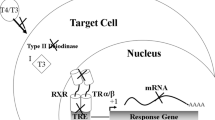Summary
Disturbances of thyroid function occur more often in the elderly than in the young. This short review gives an up-to-date overview of this topic. After discussing the difference in epidemiology of thyroid dysfunction in elderly persons in areas with different iodine nutrient status, the physiologic age-induced changes of the hypothalamic-pituitary-thyroid axis are discussed, especially with regard to their consequences on normal ranges of thyroid hormones. Although slight decreases in thyrotropin (TSH) and free triiodothyronine (T3) have been described as occurring in healthy elderly persons, it is concluded from the available data that abnormal values of thyroid hormones in serum of old people should be further investigated, since none of the described changes lead to values outside the normal range. Special emphasis is given to the fact that disturbances of thyroid function are oligosymptomatic or may even be asymptomatic in old persons. Therefore, laboratory screening for thyroid dysfunction in patients over 65 years of age seems to be justified. Lastly, differences of treatment in comparison with younger patients with hyper- or hypothyroidism are presented. The impact of subclinical disturbances of thyroid function in the elderly and their possible therapeutic consequences are also included in this discussion.
Zusammenfassung
Störungen der Funktion der Schilddrüse treten im Alter wesentlich häufiger auf als bei jungen Menschen. Die vorliegende kurze Übersicht gibt den momentanen Stand des Wissens über dieses Phänomen wieder. Schon bei gesunden alten Menschen kommt es zu "physiologischen" Veränderungen: ein vielfach beschriebener – geringer – altersbedingter Abfall von TSH und Trijodthyronin weist auf eine partielle sekundäre Hypothyreose hin. Dieser beschriebene Abfall bei Gesunden liegt aber den vorliegenden Daten nach praktisch nie außerhalb des Normbereichs, weshalb abnorme Werte auch bei alten Menschen immer weiter abgeklärt werden müssen. Eine Ausnahme stellen schwere nicht-thyreoidale Erkrankungen dar. Der Einfluss der Jodversorgung auf die Erscheinungsform der Funktionsstörung im Alter (Hyperthyreose bei Jodmangel – Hypothyreose bei guter J-Versorgung) wird ebenso besprochen wie die zwischen Alt und Jung unterschiedliche Symptomatologie der Schilddrüsenfunktionsstörungen. Da die Funktionsstörungen bei alten Menschen oligo- bis asymptomatisch verlaufen können, scheinen Screeninguntersuchungen in Anbetracht der hohen Prävalenz der Erkrankung vor allem bei Frauen ab dem 65. Lebensjahr gerechtfertigt. Abschließend wird noch auf die Besonderheiten der Therapie bei alten Menschen hingewiesen, wobei auch auf die Problematik der Therapie der subklinischen Funktionsstörungen eingegangen wird.
Similar content being viewed by others
Author information
Authors and Affiliations
Corresponding author
Rights and permissions
About this article
Cite this article
Weissel, M. Disturbances of thyroid function in the elderly. Wien Klin Wochenschr 118, 16–20 (2006). https://doi.org/10.1007/s00508-005-0504-y
Issue Date:
DOI: https://doi.org/10.1007/s00508-005-0504-y




